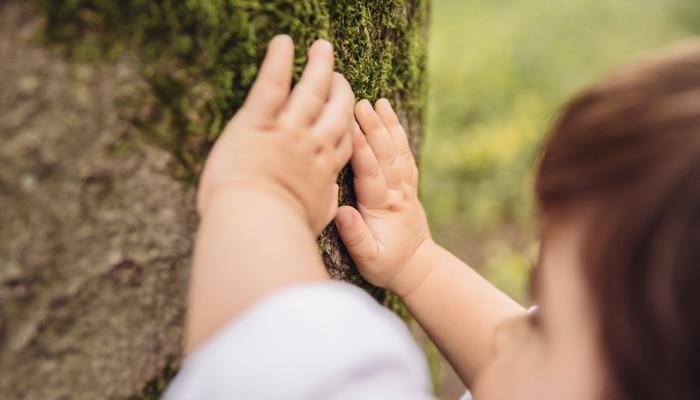While we believe that the books and resources recommended may be of value to you, keep in mind that these are suggestions only and you must do your own due diligence to determine whether the materials are appropriate and suitable for your use. PNC has no sponsorship or endorsement agreement with the authors or publishers of the materials listed.
MY FIVE SENSES

Touchable Textures
Children will learn about the sense of touch.

Lesson Objective
Children will explore the sense of touch by examining a variety of textured materials.
Science
What You'll Need
- Cardboard squares, about 4” x 4” – 2 per texture
- A variety of textured items such as yarn, velvet, corduroy, lace, sandpaper, buttons, flannel, tinfoil, pebbles, salt, cotton balls, wool, sequins, pipe cleaners, and gift wrap – enough to cover two 4”x4” squares
- A large opaque container, such as a paper grocery bag or a box with a cover
- Items from around the classroom that have a distinct shape or texture, such as toy cars, chalk, crayons, puzzle pieces, small balls, etc.
- Glue
- Chart paper and marker
What To Do
Note: This lesson requires preparation prior to the day of the lesson.
To create the sensory cards:
- Create two sets of sensory cards: one set for the children and one set for the teacher.
- Cut the cardboard into 4-inch squares, two for each sensory item.
- Glue each of the sensory items (yarn, tinfoil, sandpaper, etc.) onto each of two cards.
- Make a large number of cards for variety. The more variety of textures the better the activity.
- Let the cards dry overnight.
Part 1
- Put the objects that you have collected from the classroom into the large container (close it so that the children cannot see what is inside).
- Assure the children that there is nothing scary in the container; all of the items are from their classroom. Have one of the children close his or her eyes and reach into the container to feel one of the objects without pulling it out of the container.
- Ask the children if they can guess what they are feeling, name the object, then pull it out and look at it. Encourage the children by asking probing questions (see Guiding Student Inquiry). Invite each child to take a turn.
Part 2
- Distribute the cards from the children’s set of texture cards, one per child, and have them use just their fingertips to explore.
- Encourage the children to take turns describing what they feel. Write their descriptive words on the chart paper. Provide enhanced vocabulary when needed, emphasizing words such as soft, rough, scratchy, smooth, cool, warm, and hard.
- Give the children time to compare and contrast their cards with each other.
- Select one of your cards and show it to the children.
- Ask the children to find the matching texture card. Encourage the children to touch your card and their own cards to compare the textures.
- When you locate the child with the matching card, let him or her hold both cards. Select another card and repeat the process until each child has matching texture cards.
Resources
Home School Resources
Home educators: use these printable lesson PDFs to teach this lesson to your home schoolers. They're available in English and Spanish.
Content Provided By
Common Core State Standards Initiative – These lessons are aligned with the Common Core State Standards ("CCSS"). The CCSS provide a consistent, clear understanding of the concepts and skills children are expected to learn and guide teachers to provide their students with opportunities to gain these important skills and foundational knowledge [1]. Visit the CCSS


